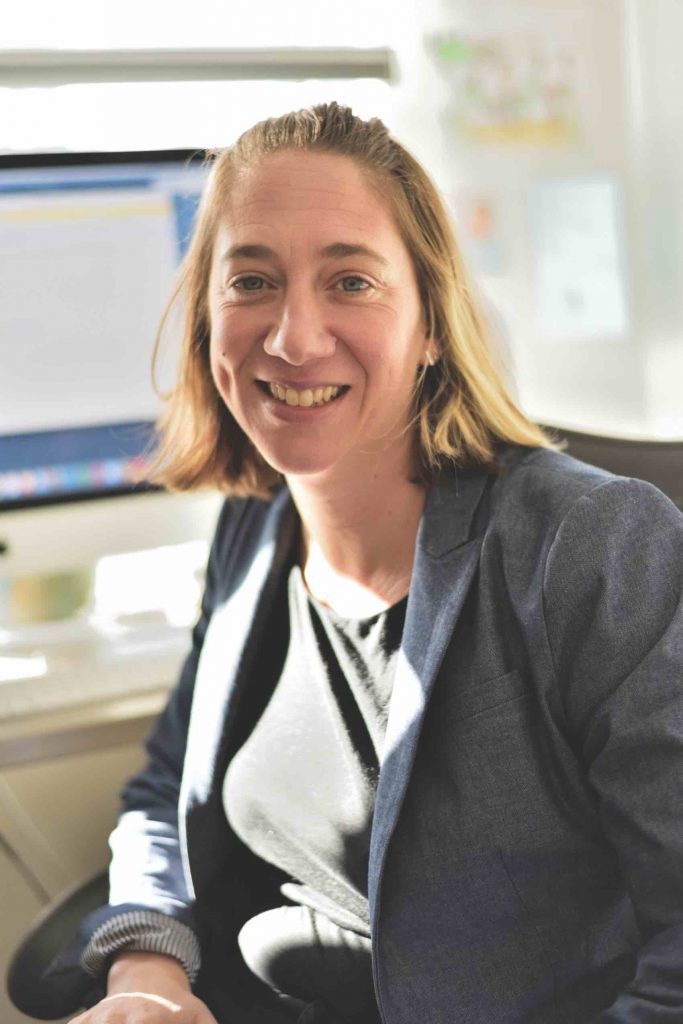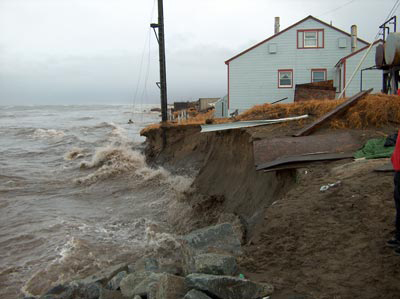By Jim Yuskavitch
Late last year, residents of Sugarloaf Key got some bad news from the county. They might have to move away from their subtropical island off the southern tip of Florida — and perhaps soon. High tides combined with rising sea levels are flooding the Key’s roads deeper and for longer periods of time each year.
The county estimates that raising just three miles of road to keep it dry year-round in 2025 will cost $75 million and $128 million by 2045. With 300 miles of roads, the cost to retrofit all of them against rising seas is unaffordable. Sooner or later, many people will have to find another place to live. The Florida Keys may someday have far fewer residents.
Nearly 5,000 miles away, in the opposite corner of North America on Sarichef Island off Alaska’s Seward Peninsula, is another community with the same problem. In Shishmaref, coastal erosion driven by climate change will also eventually force its residents to move. But that’s where the similarities between the two communities end. On Sugarloaf Key, the majority of residents are European-American, many of whom relocated from the North to retire. A significant number are affluent enough to live in gated mansions. When the time comes, they will scatter to other cities and neighborhoods to start over, just as they did when they moved to the Keys.

Far from the coconut palms and expensive real estate, Shishmaref is an indigenous Inupiat village of about 600 people. They occupy a barrier island, a sub-Arctic landscape where their ancestors arrived, adapted and thrived, perhaps as far back as 20,000 years ago. Residents here share a culture, family ties, an ancestral past and a deep spiritual and economic connection to the land. When they move, they will do so together as one, informed by all those things that Elizabeth Marino calls a “sense of place.”
Marino is an assistant professor of anthropology and co-director of The Laboratory for the American Conversation at Oregon State University-Cascades in Bend. Last fall, she received a $750,000 grant from the National Science Foundation to conduct a three-year study to assess how well federal programs address the unique requirements of socially and culturally cohesive communities like Shishmaref.

“We want to know how to create policies that meet the needs of these communities,” says Marino. The goal is to help coastal communities cope with severe storms and repetitive flooding.
Out of Harm’s Way
Her research couldn’t be more timely. Rising sea levels from melting ice sheets, thermal expansion of the ocean and sinking coastlines due to natural geological and human-caused processes are making some areas vulnerable to climate change and increasing instances of repetitive flooding.
Federal programs help people affected by such flooding, primarily through the Federal Emergency Management Agency: flood insurance, renovation of structures to be more flood proof, property buyouts and relocation of buildings out of flood zones. Rebuilding flood damaged homes and other structures through the National Flood Insurance Program is now the most common remedy. But as rising seas continue to encroach on vulnerable coastal communities and repetitive flooding becomes more severe, relocations may eventually be the only solution in some regions.
Currently, while only 1% of properties that experience repetitive flooding are insured under the flood insurance program, they make up as much as a third of flood damage claims. That figure is likely to only increase over time.

Federal flood assistance programs, especially for relocations, tend to focus on individuals and households rather than on cohesive communities with group decision-making traditions like Shismaref. People in these locales need to move not only together and intact but to a culturally compatible location where residents can adapt rather than just try to cope in a new and unfamiliar home.
That’s a concern for Marino. “The best illustration is forced displacement, when a dam is built and an indigenous community is forced to move. If it’s not done right, we see some very bad outcomes including families breaking up, loss of land, increased illness, higher mortality rates and lower incomes.”
Marino first became interested in how climate change is affecting indigenous people in Alaska while working for a newspaper in Nome. The Arctic is being especially hard hit by climate change with air temperatures rising twice as fast as the rest of the world over the past five years and summer sea ice at its lowest point last year since measurements were begun in 1979. Now, with storms blowing in from the ocean no longer buffered by shore ice, combined with melting permafrost, coastal communities like Shishmaref are seeing the earth beneath their homes literally washed out to sea.
Cultural changes have also increased these communities’ vulnerability to climate change. Inupiat and other indigenous groups were forced to abandon traditional migratory lifestyles and to settle into permanent villages. They lost their ability to relocate on their own when environmental conditions became inhospitable, leaving them less resilient.
Policy Analysis
Marino went back to graduate school and earned her Ph.D. at the University of Alaska, Fairbanks, studying the effects of climate change on the environment and culture in Shishmaref. In 2015, she published the book, Fierce Climate, Sacred Ground: An Ethnography of Climate Change in Shishmaref, Alaska, detailing her experiences and observations while living and working there.
Along with colleagues Julie Raymond-Yakoubian, Alessandra Jerolleman, Annie Weylouanna and Meghan Topkok, Marino will use her NSF funding to analyze federal relocation programs and policies for communities experiencing repetitive flooding. They’ll look at past relocations of people and communities in Alaska and other regions of the United States. How effective are current disaster relocation programs, they’ll want to know. How can they be improved to meet the cultural and social needs of indigenous and similar communities that may require disaster-related relocation, whether by modifying current programs, developing new ones or even creating new agencies? Working closely with elders and other tribal members, they’ll also be looking at what a culturally relevant relocation is from the perspective of Inupiat people. What does it take, she asks, to help relocated communities successfully adapt to a new home?
Predictive models of relocation will shed light on the outcomes. “We want to look at these disaster policies and be able to say if you do this, this will happen and if you do that, that will happen,” says Marino.
The bulk of the research will focus on Alaska, where 31 indigenous coastal villages are at risk from climate-change flooding and a dozen have requested, and still await, federal relocation assistance. But Marino and her colleagues will also examine selected communities experiencing repetitive flooding along the Atlantic Seaboard, Gulf Coast and Mississippi River. These communities, which include those that are rural, agriculture-based or African-American majority, are similar to indigenous communities in their shared cultural backgrounds and social cohesiveness. And, like indigenous communities, they are often underserved and lack political influence that present barriers when they seek flooding or other disaster assistance. The researchers will build profiles of these communities to develop disaster policies that serve their unique situations.
On the Oregon Coast
Just as maintaining a sense of place for close-knit communities is crucial for success, so is understanding the cultural identity of vulnerable populations when responding to other kinds of disasters. Close to home is the Latinx population along the Oregon coast where a tsunami could be triggered by an offshore earthquake along the Cascadia Subduction Zone.
Current tsunami disaster plans include identifying key facilities that will be needed for effective disaster response such as hospitals and police and fire stations. While those facilities and their staff will play key roles in an emergency situation, they may not be as effective in helping the Latinx community as other groups.
Katie Stanton, a graduate student at OSU’s Corvallis campus, is working on her master’s degree in cultural/linguistic anthropology. A former student of Marino’s, she has been interviewing people in the Latinx communities in Clatsop County and in Newport to find ways to ensure they have the resources they need during a disaster.
“Vulnerable populations don’t utilize these facilities in the same way that other populations do,” Stanton explains. “They may fear police stations and, if they don’t have health insurance, may not know how to navigate a hospital or see it as a place to get help.”
She’s finding that churches, recreation centers and nonprofit organizations are the kinds of places the Latinx community would more likely turn to in a disaster. Knowing this, planners can ensure that these facilities have the resources to help the Latinx population during emergencies.
This is as much a social justice issue as a push for more effective disaster planning. The inequities show up in an Inupiat village whose land is eroding away, in a repeatedly flooded riverside African-American community in the South, and in a Pacific Island nation being slowly swallowed by the sea. The communities and people now experiencing these impacts are often those who have done little to contribute to climate change and may ultimately bear the brunt of the damage.
“Disasters don’t affect everyone equally,” says Marino. “So we need to understand how to create social justice as we mitigate for climate change.”
Jim Yuskavitch is a freelance writer and photographer in Sisters, Oregon.
